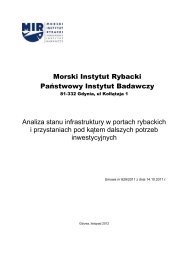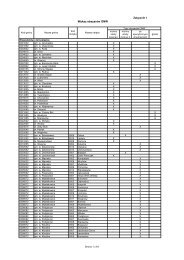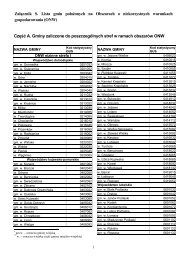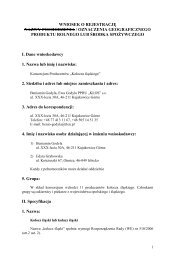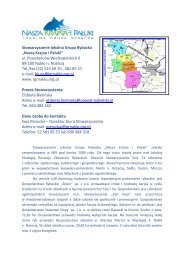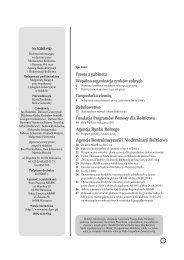agriculture and food economy in poland
agriculture and food economy in poland
agriculture and food economy in poland
Create successful ePaper yourself
Turn your PDF publications into a flip-book with our unique Google optimized e-Paper software.
The number of organic farms has been cont<strong>in</strong>uously go<strong>in</strong>g up; <strong>in</strong> 2003 it<br />
<strong>in</strong>creased by 15.6% on the previous year. Nevertheless, the number of organic farms<br />
<strong>in</strong> Pol<strong>and</strong> rema<strong>in</strong>s small, consider<strong>in</strong>g that nearly all its soils meet high<br />
environmental requirements, i.e. they are not polluted with heavy metals <strong>and</strong> other<br />
<strong>in</strong>dustrial pollutants as well as fertilisers <strong>and</strong> pesticides.<br />
Population <strong>and</strong> human resources <strong>in</strong> <strong>agriculture</strong><br />
Accord<strong>in</strong>g to the General Population <strong>and</strong> Hous<strong>in</strong>g Census <strong>and</strong> the Agricultural<br />
Census, conducted <strong>in</strong> 2002, 10 474 500 people, i.e. 27.4% of Pol<strong>and</strong>’s population,<br />
lived <strong>in</strong> households connected with a farm (area of more than 10 ares) user. Eighty<br />
per cent or 8 504 900 people were <strong>in</strong>habitants of rural areas. This implies that<br />
58.2% of the total rural population was connected with farm<strong>in</strong>g through a common<br />
household.<br />
As compared to the results of the 1996 General Agricultural Census, the number<br />
of people <strong>in</strong> agricultural hold<strong>in</strong>gs fell by 1 084 700 or 9.4%. The number of persons<br />
liv<strong>in</strong>g off work <strong>in</strong> agricultural hold<strong>in</strong>gs is constantly decreas<strong>in</strong>g, whereas that of<br />
people ma<strong>in</strong>ta<strong>in</strong>ed by farmers or with non-ga<strong>in</strong>ful sources of <strong>in</strong>come (ma<strong>in</strong>ly old age<br />
<strong>and</strong> disability pensions) is <strong>in</strong>creas<strong>in</strong>g.<br />
As regards the education level, the situation improved, though the number of<br />
people with tertiary, post-secondary or secondary education is much lower <strong>in</strong> rural<br />
areas <strong>and</strong> the farm<strong>in</strong>g sector than <strong>in</strong> towns.<br />
Compared to the EU-15 average, the structure of agricultural hold<strong>in</strong>g users <strong>in</strong><br />
Pol<strong>and</strong> is more favourable.<br />
Figure 15. Structure of agricultural hold<strong>in</strong>g users <strong>in</strong> the EU <strong>and</strong> <strong>in</strong> Pol<strong>and</strong> (%)<br />
13,3<br />
12,3<br />
56,8<br />
AGRICULTURE<br />
Pol<strong>and</strong> UE<br />
17,5<br />
Source: GUS <strong>and</strong> FAPA (data for the EU – 1993, for Pol<strong>and</strong> – 2002)<br />
25<br />
24,9<br />
28,3<br />
up tp 35 36-54 55-64 >65<br />
years years years years<br />
8,7<br />
38,1




